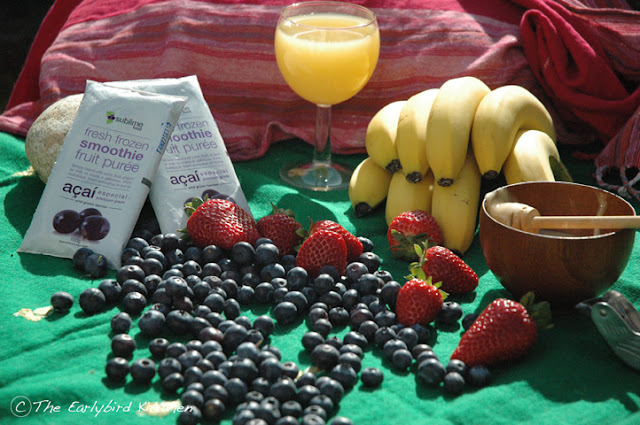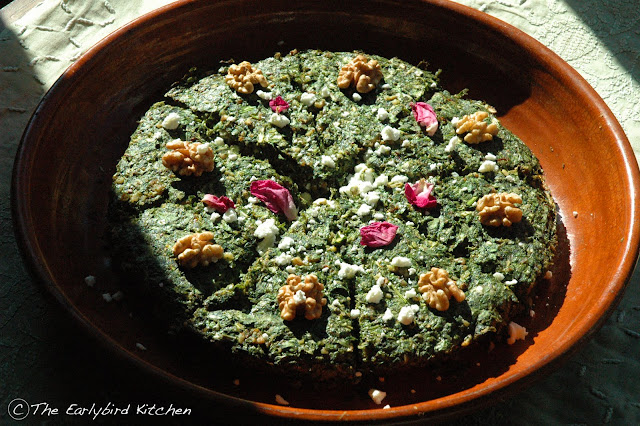Maharastrian Sabudchana Vada with Peanut Chutney and Ginger Chai
During the busiest and holiest month of Shavran Maas, the fifth month in the Hindu calendar, it is said that the devout who faithfully observe the fasting days, which always fall on a Monday, will have all their wishes and hopes come true. It is an auspicious and special time for Hindu's and one that many observe through strict fasting. During this time particular foods are omitted from the diet, no onions, garlic, wheat or pulses are included in their cooking and spicy foods are mostly avoided. The simple reason being, that during the monsoon season when Shavran Maas occurs the farmers are busy harvesting crops and planting new ones especially if a long monsoon happens. It is a very important time in the farmers calendar and the workforce needs their energy and optimum health for their assured success. Simple, mild, but tasty protein-rich dishes are traditionally offered, to support them during the onset of this hectic season.
This recipe for these
tasty snacks are a very popular choice during the monsoon season, especially for breakfast or at Tiffin time. They are
made from the small white pearl that comes from the Sago Palm. Many people will
recall this grain from English schooldays, when it would appear in the form of a
pudding and gained the unfortunate name of frogspawn. In many parts of Asia this small grain is used in both sweet and
savoury dishes and has recently found popularity in the West via the adopted
craze of Asian Bubble or Pearl Tea, which originates from Taiwan.
Sabudchana Vada may be
prepared the night before and kept covered in the fridge, ready for cooking up first
thing in the morning. Traditionally these Vada are served with chutney made from peanuts and yoghurt, I have seen them dipped into tomato ketchup with a little dried chilli added for extra heat.
These snacks, enjoyed during the monsoon season, are something people look forward to in India and are to be found on many of the busy street snack stalls and homes around the state of Maharashtra during this time. Autumn is now upon us here in England, a time to enjoy the fruits of our own harvests. This easy recipe will surprise you with its simplicity and clean taste and it will become one that you look forward to making at any time of the year. The ingredients themselves are simple and easy to find and most likely could be made from your store cupboard staples. So when there is a chill in the air and you want a different start to your day, these are just the antedote. Crunchy on the outside, soft and melting inside with a delicious extra crunch from the roasted peanuts. They make the perfect break for any fast, not just if you are a Hindu.
These snacks, enjoyed during the monsoon season, are something people look forward to in India and are to be found on many of the busy street snack stalls and homes around the state of Maharashtra during this time. Autumn is now upon us here in England, a time to enjoy the fruits of our own harvests. This easy recipe will surprise you with its simplicity and clean taste and it will become one that you look forward to making at any time of the year. The ingredients themselves are simple and easy to find and most likely could be made from your store cupboard staples. So when there is a chill in the air and you want a different start to your day, these are just the antedote. Crunchy on the outside, soft and melting inside with a delicious extra crunch from the roasted peanuts. They make the perfect break for any fast, not just if you are a Hindu.
Sabudchana Vada
Makes about 20
170 gms Small Sago Pearls
225 gms Mashed Potato
165 gms Toasted Peanuts (chopped)
1 tspn Whole Cumin Seed
1 tspn Cumin Powder
1 tspn Coriander Powder
1 tspn Lemon Juice
2 Fresh Green Chillis (finely chopped)
1 tspn Salt
2 tblspn Fresh Coriander
1 tblspn Fresh Ginger (finely chopped)
Pinch of Sugar
Wash and soak the sago in fresh water for a minimum of 4 hours if you are using large sago. If the smaller sago is used, which is the variety I have used in this recipe, then only 20 minutes soaking time is required. The pearls will swell to about double in size and they need to be soft, but not too wet, let them drain for at least an hour before you use them. Use this time to crack your peanuts from the shells and take the red skins off. Chop the nuts with a knife to create a chunky texture. If you blend them, they will be a powder and half of the pleasure of a Sabudchana Vada is the crunch you get from the peanuts. Combine all of the above ingredients into a bowl and with your hands make a soft dough, with all the ingredients evenly distributed. Wash and dry your hands and rub a little oil onto the palms of your hands, this will prevent the dough sticking whilst making up the balls. This mix will make about 20 medium Vada, if you want smaller ones just roll your balls accordingly. Roll the dough with your hands into ping pong sized balls, then gently press them down flat until they are about 1cm thick. Place them in the fridge for at least 30 minutes to firm up.

These Vada can be shallow fried in about a cm of vegetable oil. The oil needs to be hot to create a crunchy exterior and to stop the potato and sago soaking the oil up during cooking and making them greasy. If using a deep fat fryer the temperature of the oil needs to be somewhere between 350F-375F. An alternative would be to lightly spray them with some oil and place in a hot oven for 20 minutes. Whichever method you prefer, cook the Vada until they are golden brown on all sides. Remove from the heat and let them cool on some kitchen roll for a few minutes. Serve with the cool Peanut Chutney and a cup of hot Ginger Chai.
Peanut Chutney
Makes about 20
170 gms Small Sago Pearls
225 gms Mashed Potato
165 gms Toasted Peanuts (chopped)
1 tspn Whole Cumin Seed
1 tspn Cumin Powder
1 tspn Coriander Powder
1 tspn Lemon Juice
2 Fresh Green Chillis (finely chopped)
1 tspn Salt
2 tblspn Fresh Coriander
1 tblspn Fresh Ginger (finely chopped)
Pinch of Sugar
Wash and soak the sago in fresh water for a minimum of 4 hours if you are using large sago. If the smaller sago is used, which is the variety I have used in this recipe, then only 20 minutes soaking time is required. The pearls will swell to about double in size and they need to be soft, but not too wet, let them drain for at least an hour before you use them. Use this time to crack your peanuts from the shells and take the red skins off. Chop the nuts with a knife to create a chunky texture. If you blend them, they will be a powder and half of the pleasure of a Sabudchana Vada is the crunch you get from the peanuts. Combine all of the above ingredients into a bowl and with your hands make a soft dough, with all the ingredients evenly distributed. Wash and dry your hands and rub a little oil onto the palms of your hands, this will prevent the dough sticking whilst making up the balls. This mix will make about 20 medium Vada, if you want smaller ones just roll your balls accordingly. Roll the dough with your hands into ping pong sized balls, then gently press them down flat until they are about 1cm thick. Place them in the fridge for at least 30 minutes to firm up.

These Vada can be shallow fried in about a cm of vegetable oil. The oil needs to be hot to create a crunchy exterior and to stop the potato and sago soaking the oil up during cooking and making them greasy. If using a deep fat fryer the temperature of the oil needs to be somewhere between 350F-375F. An alternative would be to lightly spray them with some oil and place in a hot oven for 20 minutes. Whichever method you prefer, cook the Vada until they are golden brown on all sides. Remove from the heat and let them cool on some kitchen roll for a few minutes. Serve with the cool Peanut Chutney and a cup of hot Ginger Chai.
Peanut Chutney
120 ml Natural Yoghurt
75 gms Toasted Peanuts (finely chopped)
Pinch of Red Chilli Powder
1 tsp Cumin Powder
Salt to taste
Coriander leaves to garnish
Dry roast the peanuts in a hot pan until golden brown. Once cool, chop finely and combine with the above ingredients. Let it sit together for at least an hour in the fridge prior to serving, his allows the flavours combine. Sprinkle with a little fresh coriander.
Ginger Chai
Makes 4 small cups
2 Indian Tea-bags of your choice
1 Pint Water
1/2 pint Fresh Milk
2 Crushed Cardamom Pods
3 Cloves
1/2 Stick Cinnamon
1/2 tspn Freshly grated Nutmeg
2 tspns Finely Chopped Fresh Ginger
4 tspns Brown Sugar
Place all the above ingredients, except the milk, into a pan and bring to the boil. Once boiling let the liquid simmer for a further 5 minutes. After 5 minutes, add the milk and bring to the boil again. Take the pan off the heat and allow to cool slightly. Strain and serve.
75 gms Toasted Peanuts (finely chopped)
Pinch of Red Chilli Powder
1 tsp Cumin Powder
Salt to taste
Coriander leaves to garnish
Dry roast the peanuts in a hot pan until golden brown. Once cool, chop finely and combine with the above ingredients. Let it sit together for at least an hour in the fridge prior to serving, his allows the flavours combine. Sprinkle with a little fresh coriander.
Ginger Chai
Makes 4 small cups
2 Indian Tea-bags of your choice
1 Pint Water
1/2 pint Fresh Milk
2 Crushed Cardamom Pods
3 Cloves
1/2 Stick Cinnamon
1/2 tspn Freshly grated Nutmeg
2 tspns Finely Chopped Fresh Ginger
4 tspns Brown Sugar
Place all the above ingredients, except the milk, into a pan and bring to the boil. Once boiling let the liquid simmer for a further 5 minutes. After 5 minutes, add the milk and bring to the boil again. Take the pan off the heat and allow to cool slightly. Strain and serve.







Comments
Post a Comment